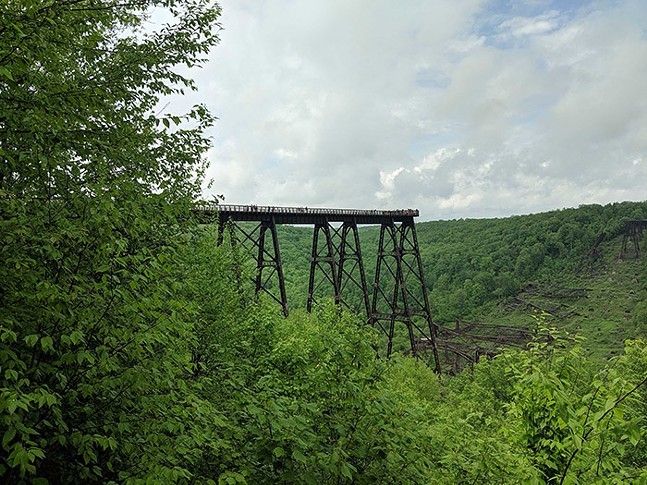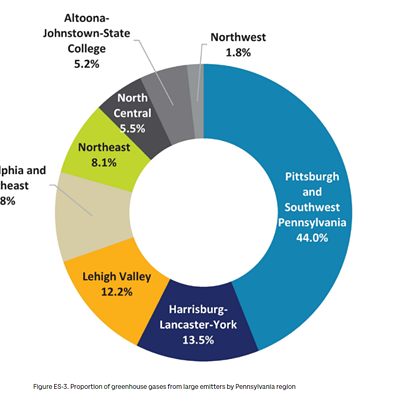Pennsylvania among worst states in nation in outdoor economic value, says study
Pennsylvania has more than 300,000 acres of state parks where people can hike, picnic, camp, fish, hunt, and more, but a new study from Outdoorsy shows the Keystone State is one of the lowest performers in terms of how much outdoor recreation contributes to the state's economy. According to the study, outdoor recreation contributes 1.6% of Pennsylvania’s annual Gross Domestic Product (GDP), compared to 2.2% nationally.
The report draws from data from the U.S. Bureau of Economic Analysis’s 2019 Outdoor Recreation Satellite Account and ranks states by their economic dependency on outdoor recreation based on the outdoor recreation industry’s share of GDP, employment, and compensation in each state. Pennsylvania received a 6.2 on the outdoor recreation dependency index, falling far behind states such as South Carolina, at 74.6, and New Hampshire, at 82.8, both of which were in the top 15 of state's economically dependent on outdoor recreation.
While Pennsylvania ranks 24th in highest percentage of land covered in state parks and national parks, and contains popular outdoor recreation destinations like the Laurel Highlands and the Pocono Mountains, it still falls behind states with comparable percentages of parkland such as New Hampshire, which ranks 20 for state and national parks but has much higher an outdoor recreation dependency index. Pennsylvania also trails states with lower rankings, such as South Carolina, which ranks 35 for state and national parks.
According to the report, outdoor recreation is defined beyond activities such as hiking, boating, and fishing. Sports such as golf and tennis; RVing; festivals, sporting events, and concerts; amusement parks and water parks; and snow activities like skiing and snowboarding also fall under the broad category when they are counted towards GDP.
Pennsylvania ties with Ohio as the second lowest state in the country in terms of outdoor economic value, as measured by GDP. Pennsylvania outdoor recreation's provides 2.2% of its employment compared to 2.5% nationally, and while it fares better in terms of percentage of total employment compared to Ohio, it sinks back to the bottom for percentage of total compensation from outdoor recreation employment, tying for third with Ohio, Texas, and Virginia at 1.5% compared to 2% nationally. Only Connecticut fares worse than Pennsylvania for economic output among U.S. states.
Across the nation, boating and fishing represented the most economically impactful activities in 2019, followed by game areas; RVing; festivals, sporting events, and concerts; amusement parks and water parks; and snow activities. Comparatively, game areas, which includes golf and tennis, are the largest contributor in Pennsylvania, bringing in a little more than $696.6 million, representing about 5.3% of the total outdoor recreation value added.
Festivals, RVing, and boating and fishing are also major contributors in Pennsylvania, all contributing more than $500 million each. Amusement parks and water parks and snow activities are the least impactful activities, contributing 275.9 million and 236.6 million, respectively.
Pennsylvania's low outdoor recreation economic rating might not surprise many. The state has historically been focused on the extraction of natural resources to power much of its economy, with timber, oil, coal, and steel all experiences booms and subsequent busts in the state. A large focus is still being played to resource extraction with Pennsylvania's support of natural-gas drilling, aka fracking, and related industries like petrochemical plants. Environmentalist have long decried fracking for its environmental degradation and pollution, and economists are mixed on whether it will see an economic rebound post-pandemic.
The report draws from data from the U.S. Bureau of Economic Analysis’s 2019 Outdoor Recreation Satellite Account and ranks states by their economic dependency on outdoor recreation based on the outdoor recreation industry’s share of GDP, employment, and compensation in each state. Pennsylvania received a 6.2 on the outdoor recreation dependency index, falling far behind states such as South Carolina, at 74.6, and New Hampshire, at 82.8, both of which were in the top 15 of state's economically dependent on outdoor recreation.
While Pennsylvania ranks 24th in highest percentage of land covered in state parks and national parks, and contains popular outdoor recreation destinations like the Laurel Highlands and the Pocono Mountains, it still falls behind states with comparable percentages of parkland such as New Hampshire, which ranks 20 for state and national parks but has much higher an outdoor recreation dependency index. Pennsylvania also trails states with lower rankings, such as South Carolina, which ranks 35 for state and national parks.
According to the report, outdoor recreation is defined beyond activities such as hiking, boating, and fishing. Sports such as golf and tennis; RVing; festivals, sporting events, and concerts; amusement parks and water parks; and snow activities like skiing and snowboarding also fall under the broad category when they are counted towards GDP.
Pennsylvania ties with Ohio as the second lowest state in the country in terms of outdoor economic value, as measured by GDP. Pennsylvania outdoor recreation's provides 2.2% of its employment compared to 2.5% nationally, and while it fares better in terms of percentage of total employment compared to Ohio, it sinks back to the bottom for percentage of total compensation from outdoor recreation employment, tying for third with Ohio, Texas, and Virginia at 1.5% compared to 2% nationally. Only Connecticut fares worse than Pennsylvania for economic output among U.S. states.
Across the nation, boating and fishing represented the most economically impactful activities in 2019, followed by game areas; RVing; festivals, sporting events, and concerts; amusement parks and water parks; and snow activities. Comparatively, game areas, which includes golf and tennis, are the largest contributor in Pennsylvania, bringing in a little more than $696.6 million, representing about 5.3% of the total outdoor recreation value added.
Festivals, RVing, and boating and fishing are also major contributors in Pennsylvania, all contributing more than $500 million each. Amusement parks and water parks and snow activities are the least impactful activities, contributing 275.9 million and 236.6 million, respectively.
Pennsylvania's low outdoor recreation economic rating might not surprise many. The state has historically been focused on the extraction of natural resources to power much of its economy, with timber, oil, coal, and steel all experiences booms and subsequent busts in the state. A large focus is still being played to resource extraction with Pennsylvania's support of natural-gas drilling, aka fracking, and related industries like petrochemical plants. Environmentalist have long decried fracking for its environmental degradation and pollution, and economists are mixed on whether it will see an economic rebound post-pandemic.




















